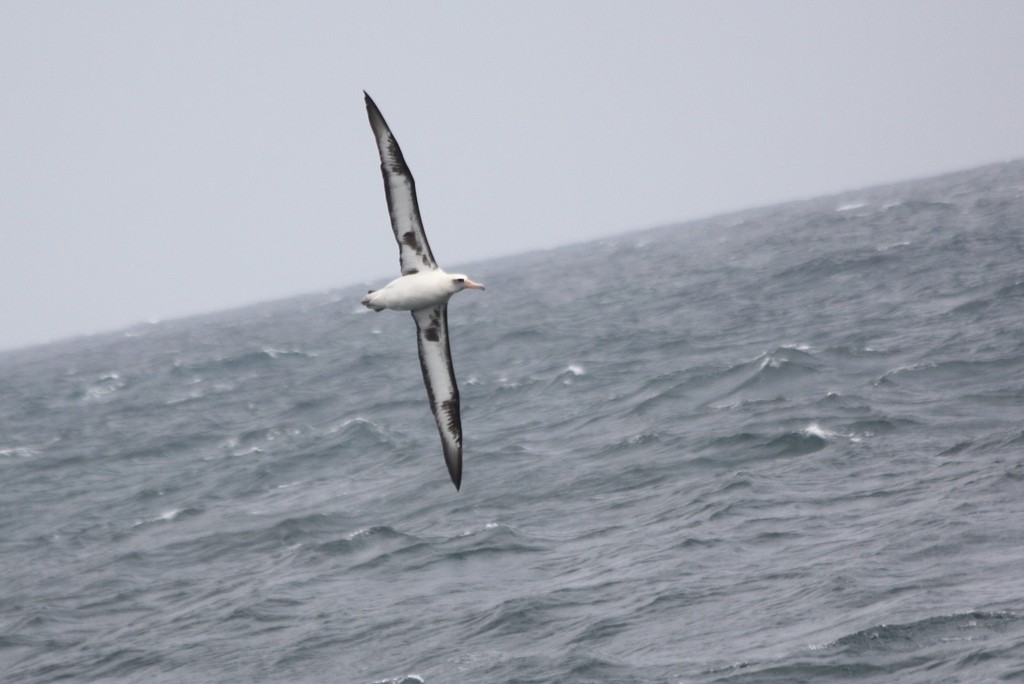Laysan Albatross
A species of North Pacific Albatrosses Scientific name : Phoebastria immutabilis Genus : North Pacific Albatrosses
Laysan Albatross, A species of North Pacific Albatrosses
Botanical name: Phoebastria immutabilis
Genus: North Pacific Albatrosses
Content
Description People often ask General Info
 Photo By silversea_starsong , used under CC-BY-NC-4.0 /Cropped and compressed from original
Photo By silversea_starsong , used under CC-BY-NC-4.0 /Cropped and compressed from original Description
The Laysan albatross averages 81 cm (32 in) in length and has a wingspan of 195 to 203 cm (77–80 in). Males, which weigh 2.4 to 4.1 kg (5.3–9.0 lb), are larger than females, which weigh 1.9 to 3.6 kg (4.2–7.9 lb). This albatross has blackish-gray upperwing, mantle, back, upper rump, and tail, and its head, lower rump, and underparts are white. It has a black smudge around the eye, and its underwing pattern varies between individuals, with some having narrower black margins and variable amounts of black in the underwing coverts. Finally, the bill is pink with a dark tip. Juveniles have a gray bill and a dark upper rump. This species does not have a breeding plumage. The Laysan albatross is usually easy to identify. In the North Pacific, it is simple to separate from the other relatively common albatross, the all black black-footed albatross. It can be distinguished from the very rare short-tailed albatross by its all-dark back and smaller size. The Laysan albatross's plumage has been compared to that of a gull, two-toned with a dark gray mantle and wings and a white underside and head. 
Size
89 cm
Colors
Brown
Black
Gray
White
Life Expectancy
12 years
Nest Placement
Ground
Clutch Size
1 egg
Incubation Period
1 brood
Number of Broods
62 - 66 days
Nestling Period
165 days
Feeding Habits
Laysan Albatross's diet primarily consists of squid, complemented by fish eggs, crustaceans, carrion, and bycatch. They feed by surface seizing on the water. Foraging adults venture on extended trips, up to 17 days and over 1,600 miles, to nourish their chicks.
Habitat
Laysan Albatross thrive in the expansive North Pacific Ocean, favoring cooler, nutrient-rich waters for feeding. Their breeding grounds are characterized by open, grassy, or sandy terrains on remote islands, chiefly in the Northwestern Hawaiian Islands. About 94% of laysan Albatross's nesting occurs in these regions. They typically avoid forested, urban, and inland water areas.
Nest Behavior
Laysan Albatross exhibit nest-building by females who scrape out a circular depression, sometimes continuing construction during incubation. Egg-laying and parental care are shared duties among the pair.
Nest Characteristics
Laysan Albatross nest on sparse ground, using a shallow sand depression with a rim composed of twigs, leaves, and sand, or leaf litter and needles on larger islands. The nest has an approximate 3-foot diameter and is a few inches deep.
Dite type
Piscivorous
People often ask
General Info
Feeding Habits
Bird food type
Behavior
The laysan Albatross exhibits a remarkable mastery of dynamic soaring, an efficient flight behavior utilizing differential wind speeds to glide long distances with minimal wing movement. These majestic birds engage in a meticulous courtship that includes synchronized bill-touching, wing-spreading, head-bobbing, and sky-pointing rituals starting in November. Nesting sites bustle with activity, as laysan Albatross partner for life, returning to the colony to mate and produce a single egg annually. The ability to reproduce may take up to ten years with young laysan Albatross often unsuccessful until reaching maturity. On land, their movement is cumbersome, requiring a wind-assisted takeoff. They coexist with Black-footed Albatrosses within colonies that face terrestrial and marine predation threats.
Distribution Area
The Laysan albatross has a wide range across the North Pacific, with 16 nesting sites. All but 0.3% of the breeding population is found among the Northwestern Hawaiian Islands, particularly the islands of Midway and Laysan. Small populations are found on the Bonin Islands near Japan and the bird has begun to colonize islands off Mexico, such as Guadalupe Island and others in the Revillagigedo Archipelago. When away from the breeding areas, they range widely from Japan to the Bering Sea and south to 15°N. 
Species Status
The IUCN has classified the Laysan albatross as vulnerable due to drastic reductions in populations, but the population may be rebounding. The IUCN now classifies the Laysan albatross as near threatened. The Laysan albatross, while a common species, has not yet recovered from the wide-scale hunting of the early 1900s, with feather hunters killing many hundreds of thousands and wiping them out from Wake Island and Johnston Atoll. This slaughter led to efforts to protect the species (and others) which led eventually to the protection of the Northwestern Hawaiian Islands. The species is still vulnerable to longline fisheries and the ingestion of floating plastics due to high rates of plastic pollution. Feral cats are known to prey on nesting birds and chicks on some of the more newly colonized islands. In some places, big headed ants are a threat to young albatross chicks. The Laysan albatross has an occurrence range of 38,800,000 km (15,000,000 sq mi) and a breeding range of 3,500 km (1,400 sq mi) with a population of 1,180,000 mature birds estimated in 2006. Midway Atoll, Laysan Island, and the French Frigate Shoals have more than 90% of the breeding pairs at 551,940. Bonin Island has 23 pairs and offshore Mexico has about 400 pairs, with 337 pairs on Isla Guadalupe. The northwestern Hawaiian Islands have suffered a 32% reduction in breeders from 1992 to 2002. However, the last three years have had a rebound that stabilized the period between 1992 and 2005. This species was extirpated from Wake Atoll, Johnston Atoll, and Minami Torishima. The Mexican population has been increasing since its inception. In the past, harvesting for feathers was a major threat, along with high-seas drift net, but both of these have ceased, barring some small-scale illegal drift net operations. Current threats today are the longline fisheries. 
Scientific Classification
Phylum
Chordates Class
Birds Order
Albatrosses and Petrels Family
Albatrosses Species
Laysan Albatross